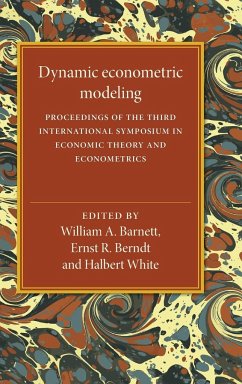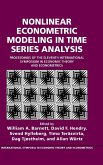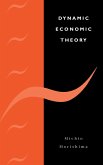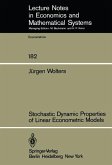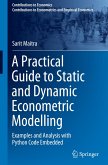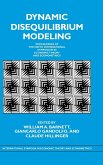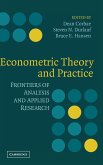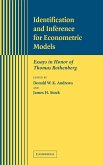Dynamic Econometric Modeling
Herausgeber: Barnett, William A.; White, Halbert; Berndt, Ernst R.
Dynamic Econometric Modeling
Herausgeber: Barnett, William A.; White, Halbert; Berndt, Ernst R.
- Gebundenes Buch
- Merkliste
- Auf die Merkliste
- Bewerten Bewerten
- Teilen
- Produkt teilen
- Produkterinnerung
- Produkterinnerung
This book brings together presentations of some of the fundamental new research that has begun to appear in the areas of dynamic structural modeling, nonlinear structural modeling, time series modeling, nonparametric inference, and chaotic attractor inference. The contents of this volume comprise the proceedings of the third of a conference series entitled International Symposia in Economic Theory and Econometrics. This conference was held at the IC;s2 (Innovation, Creativity and Capital) Institute at the University of Texas at Austin on May 22-23, l986.
Andere Kunden interessierten sich auch für
![Nonlinear Econometric Modeling in Time Series Nonlinear Econometric Modeling in Time Series]() A. Barnett / F. Hendry / Svend Hylleberg / Timo Teräsvirta / Dag Tjøstheim / Allan Würtz (eds.)Nonlinear Econometric Modeling in Time Series136,99 €
A. Barnett / F. Hendry / Svend Hylleberg / Timo Teräsvirta / Dag Tjøstheim / Allan Würtz (eds.)Nonlinear Econometric Modeling in Time Series136,99 €![Dynamic Economic Theory Dynamic Economic Theory]() Michio MorishimaDynamic Economic Theory80,99 €
Michio MorishimaDynamic Economic Theory80,99 €![Stochastic Dynamic Properties of Linear Econometric Models Stochastic Dynamic Properties of Linear Econometric Models]() J. WoltersStochastic Dynamic Properties of Linear Econometric Models39,99 €
J. WoltersStochastic Dynamic Properties of Linear Econometric Models39,99 €![A Practical Guide to Static and Dynamic Econometric Modelling A Practical Guide to Static and Dynamic Econometric Modelling]() Sarit MaitraA Practical Guide to Static and Dynamic Econometric Modelling64,99 €
Sarit MaitraA Practical Guide to Static and Dynamic Econometric Modelling64,99 €![Dynamic Disequilibrium Modeling Dynamic Disequilibrium Modeling]() Dynamic Disequilibrium Modeling160,99 €
Dynamic Disequilibrium Modeling160,99 €![Econometric Theory and Practice Econometric Theory and Practice]() P. Corbae / N. Durlauf / E. Hansen (eds.)Econometric Theory and Practice64,99 €
P. Corbae / N. Durlauf / E. Hansen (eds.)Econometric Theory and Practice64,99 €![Identification and Inference for Econometric Models Identification and Inference for Econometric Models]() Donald W. K. Andrews / James H. Stock (eds.)Identification and Inference for Econometric Models135,99 €
Donald W. K. Andrews / James H. Stock (eds.)Identification and Inference for Econometric Models135,99 €-
-
-
This book brings together presentations of some of the fundamental new research that has begun to appear in the areas of dynamic structural modeling, nonlinear structural modeling, time series modeling, nonparametric inference, and chaotic attractor inference. The contents of this volume comprise the proceedings of the third of a conference series entitled International Symposia in Economic Theory and Econometrics. This conference was held at the IC;s2 (Innovation, Creativity and Capital) Institute at the University of Texas at Austin on May 22-23, l986.
Produktdetails
- Produktdetails
- Verlag: Cambridge University Press
- Seitenzahl: 390
- Erscheinungstermin: 31. März 2016
- Englisch
- Abmessung: 235mm x 157mm x 27mm
- Gewicht: 782g
- ISBN-13: 9780521333955
- ISBN-10: 0521333954
- Artikelnr.: 35454548
- Herstellerkennzeichnung
- Libri GmbH
- Europaallee 1
- 36244 Bad Hersfeld
- gpsr@libri.de
- Verlag: Cambridge University Press
- Seitenzahl: 390
- Erscheinungstermin: 31. März 2016
- Englisch
- Abmessung: 235mm x 157mm x 27mm
- Gewicht: 782g
- ISBN-13: 9780521333955
- ISBN-10: 0521333954
- Artikelnr.: 35454548
- Herstellerkennzeichnung
- Libri GmbH
- Europaallee 1
- 36244 Bad Hersfeld
- gpsr@libri.de
Editors' introduction; List of contributors; Part 1. Dynamic Structural
Modeling: 1. Efficient instrumental variables estimation of systems of
implicit heterogeneous nonlinear dynamic equations with nonspherical errors
Charles Bates and Halbert White; 2. Envelope consistent functional
separability Ernst R. Berndt; 3. Flexible functional forms for profit
functions and global curvature conditions W. Erwin Diewert and Lawrence
Ostensoe; 4. Likelihood inference in the nonlinear regression model with
explosive linear dynamics Ian Domowitz and Lars Muus; 5. Exact inference in
models with autoregressive conditional heteroscedasticity John Geweke; 6.
Control of a linear regression process with unknown parameters Nicholas M.
Kiefer and Yaw Nyarko; 7. Some tests of nonparametric regression models
Adonis John Yatchew; Part II. Linear Time Series Modeling: 8. A
central-limit result for instrumental variables estimators of linear time
series models Lars Peter Hansen; 9. Exact and approximate distribution of
the t ratio test statistic in an AR(1) model Alberto Holly and Georg
Michael Rockinger; 10. The use of ARIMA models in unobserved-components
estimation: an application to Spanish monetary control Agustin Maravall;
Part III. Chaotic Attractor Modeling: 11. The aggregation-theoretic
monetary aggregates are chaotic and have strange attractors: an econometric
application of mathematical chaos William A. Barnett and Ping Chen; 12.
Theorems on distinguishing deterministic from random systems W. A. Brock
and W. D. Dechert; Part IV. Applications: 13. Investment and sales: some
empirical evidence Andrew B. Abel and Olivier J. Blanchard; 14. Me and my
shadow: estimating the size of the U.S. hidden economy from time series
data Dennis J. Aigner, Friedrich Schneider, and Damayanti Ghosh; 15.
Estimating structural models of unemployment and job duration Dale T.
Mortensen and George R. Neumann; 16. Comparison of dynamic factor demand
models Peter E. Rossi.
Modeling: 1. Efficient instrumental variables estimation of systems of
implicit heterogeneous nonlinear dynamic equations with nonspherical errors
Charles Bates and Halbert White; 2. Envelope consistent functional
separability Ernst R. Berndt; 3. Flexible functional forms for profit
functions and global curvature conditions W. Erwin Diewert and Lawrence
Ostensoe; 4. Likelihood inference in the nonlinear regression model with
explosive linear dynamics Ian Domowitz and Lars Muus; 5. Exact inference in
models with autoregressive conditional heteroscedasticity John Geweke; 6.
Control of a linear regression process with unknown parameters Nicholas M.
Kiefer and Yaw Nyarko; 7. Some tests of nonparametric regression models
Adonis John Yatchew; Part II. Linear Time Series Modeling: 8. A
central-limit result for instrumental variables estimators of linear time
series models Lars Peter Hansen; 9. Exact and approximate distribution of
the t ratio test statistic in an AR(1) model Alberto Holly and Georg
Michael Rockinger; 10. The use of ARIMA models in unobserved-components
estimation: an application to Spanish monetary control Agustin Maravall;
Part III. Chaotic Attractor Modeling: 11. The aggregation-theoretic
monetary aggregates are chaotic and have strange attractors: an econometric
application of mathematical chaos William A. Barnett and Ping Chen; 12.
Theorems on distinguishing deterministic from random systems W. A. Brock
and W. D. Dechert; Part IV. Applications: 13. Investment and sales: some
empirical evidence Andrew B. Abel and Olivier J. Blanchard; 14. Me and my
shadow: estimating the size of the U.S. hidden economy from time series
data Dennis J. Aigner, Friedrich Schneider, and Damayanti Ghosh; 15.
Estimating structural models of unemployment and job duration Dale T.
Mortensen and George R. Neumann; 16. Comparison of dynamic factor demand
models Peter E. Rossi.
Editors' introduction; List of contributors; Part 1. Dynamic Structural
Modeling: 1. Efficient instrumental variables estimation of systems of
implicit heterogeneous nonlinear dynamic equations with nonspherical errors
Charles Bates and Halbert White; 2. Envelope consistent functional
separability Ernst R. Berndt; 3. Flexible functional forms for profit
functions and global curvature conditions W. Erwin Diewert and Lawrence
Ostensoe; 4. Likelihood inference in the nonlinear regression model with
explosive linear dynamics Ian Domowitz and Lars Muus; 5. Exact inference in
models with autoregressive conditional heteroscedasticity John Geweke; 6.
Control of a linear regression process with unknown parameters Nicholas M.
Kiefer and Yaw Nyarko; 7. Some tests of nonparametric regression models
Adonis John Yatchew; Part II. Linear Time Series Modeling: 8. A
central-limit result for instrumental variables estimators of linear time
series models Lars Peter Hansen; 9. Exact and approximate distribution of
the t ratio test statistic in an AR(1) model Alberto Holly and Georg
Michael Rockinger; 10. The use of ARIMA models in unobserved-components
estimation: an application to Spanish monetary control Agustin Maravall;
Part III. Chaotic Attractor Modeling: 11. The aggregation-theoretic
monetary aggregates are chaotic and have strange attractors: an econometric
application of mathematical chaos William A. Barnett and Ping Chen; 12.
Theorems on distinguishing deterministic from random systems W. A. Brock
and W. D. Dechert; Part IV. Applications: 13. Investment and sales: some
empirical evidence Andrew B. Abel and Olivier J. Blanchard; 14. Me and my
shadow: estimating the size of the U.S. hidden economy from time series
data Dennis J. Aigner, Friedrich Schneider, and Damayanti Ghosh; 15.
Estimating structural models of unemployment and job duration Dale T.
Mortensen and George R. Neumann; 16. Comparison of dynamic factor demand
models Peter E. Rossi.
Modeling: 1. Efficient instrumental variables estimation of systems of
implicit heterogeneous nonlinear dynamic equations with nonspherical errors
Charles Bates and Halbert White; 2. Envelope consistent functional
separability Ernst R. Berndt; 3. Flexible functional forms for profit
functions and global curvature conditions W. Erwin Diewert and Lawrence
Ostensoe; 4. Likelihood inference in the nonlinear regression model with
explosive linear dynamics Ian Domowitz and Lars Muus; 5. Exact inference in
models with autoregressive conditional heteroscedasticity John Geweke; 6.
Control of a linear regression process with unknown parameters Nicholas M.
Kiefer and Yaw Nyarko; 7. Some tests of nonparametric regression models
Adonis John Yatchew; Part II. Linear Time Series Modeling: 8. A
central-limit result for instrumental variables estimators of linear time
series models Lars Peter Hansen; 9. Exact and approximate distribution of
the t ratio test statistic in an AR(1) model Alberto Holly and Georg
Michael Rockinger; 10. The use of ARIMA models in unobserved-components
estimation: an application to Spanish monetary control Agustin Maravall;
Part III. Chaotic Attractor Modeling: 11. The aggregation-theoretic
monetary aggregates are chaotic and have strange attractors: an econometric
application of mathematical chaos William A. Barnett and Ping Chen; 12.
Theorems on distinguishing deterministic from random systems W. A. Brock
and W. D. Dechert; Part IV. Applications: 13. Investment and sales: some
empirical evidence Andrew B. Abel and Olivier J. Blanchard; 14. Me and my
shadow: estimating the size of the U.S. hidden economy from time series
data Dennis J. Aigner, Friedrich Schneider, and Damayanti Ghosh; 15.
Estimating structural models of unemployment and job duration Dale T.
Mortensen and George R. Neumann; 16. Comparison of dynamic factor demand
models Peter E. Rossi.

